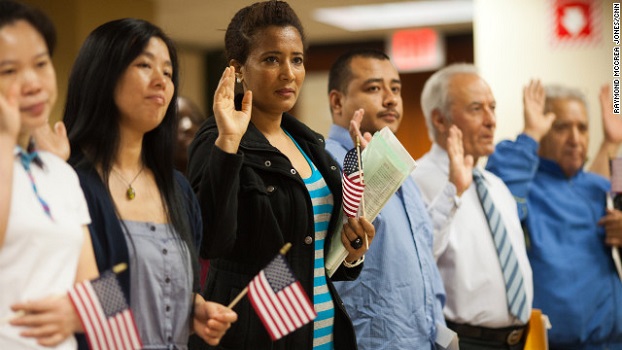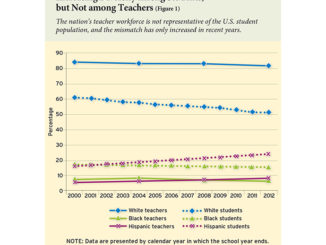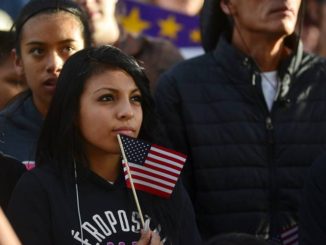
By Alex Nowrasteh
The National Academy of Sciences recently published a comprehensive report on the pace of immigrant assimilation. Short conclusion: It’s on par with previous waves of immigrants. I want to highlight one section of their report that explains why assimilation is so rapid that is only occasionally mentioned by some and totally ignored by others: ethnic attrition.
Ethnic attrition occurs when the descendants of immigrants from a particular country, let’s say Mexico, cease to identify as Mexicans, Hispanic, or Latino in surveys. This almost entirely occurs through intermarriage with spouses of different ethnic groups. This wouldn’t matter except that ethnic attrition is selective, not random, and is severe (see Table 1). Subsequent generations descended from Spanish-speaking immigrants who identify as Hispanic, Mexican, or Latino systematically differ from those who are descended from the same Spanish-speaking immigrants but who drop the self-identification.
Therefore the problem is that you can’t use polls of self-identified Mexicans, Hispanics, or Latinos born here to form an accurate picture of multi-generational assimilation. Any poll of those groups will only catch those who self-identify as such, not those born here to Mexican, Hispanic, or Latino parent(s) who do not.
Table 1
Hispanic Self-Identification with Ancestors from Spanish Speaking Country
| Most Recent Ancestor from A Spanish-Speaking Country |
Percent |
| Respondent (1st generation) |
98.7 |
| Parent(s) (2nd generation) |
83.3 |
| Grandparent(s) (3rd generation) |
73 |
| Great grandparent(s) (4th generation) |
44.4 |
| Further back (5th+generation) |
5.6 |
Source: “Ethnic Identification, Intermarriage, and Unmeasured Progress by Mexican Americans,” by Brian Duncan and Stephen J. Trejo.
Note: This information is from a small sample size of 369 from the 1970 U.S. Census Content Reinterview Study. It should be taken as suggestive rather than hard truth.
Studies that rely on the subjective Mexican self-identification of the descendants of immigrants typically find low rates of economic and educational assimilation that stall between the second and third generation. There is significant educational and economic progress after correcting for ethnic attrition and measuring all of the descendants of immigrants. Below are the major papers in the ethnic attrition literature.
Duncan and Trejo’s 2007 seminal paper showed that Hispanic self-identification fades by generation and that correcting for ethnic attrition reveals far more socioeconomic progress than other methods of measuring assimilation. Looking at the microdata from the 1970 US Census for everyone who had at least one ancestor for a Spanish-speaking country shows significant attrition (Table 1). Virtually all (99 percent) of immigrants from Spanish-speaking countries self-identified as Hispanic, 83 percent of the second generation, 73 percent of the third, 44 percent of the fourth, and 6 percent of the fifth and higher generations.
Intermarriage plays a central role in explaining the rapid loss of Hispanic self-identification. In the 1970 data, 97 percent of Americans with Hispanic ancestry on both sides of the family self-identified as Hispanic while only 21.4 of those with Hispanic ancestry on one side of the family did so. Their analysis of 62,734 marriages in the 2000 Census found a high rate of intermarriage (Table 2).
Table 2
U.S. Born Mexican-Americans and Their Spouses
|
US-Born Mexicans |
||
| Spouse |
Husbands |
Wives |
| U.S. Born Mexicans |
50.6 |
45.3 |
| Foreign Born Mexicans |
13.6 |
17.4 |
| Other Hispanics |
4.2 |
4.1 |
| Other Races, Ethnicities |
31.6 |
33.2 |
| All |
100 |
100 |
| Non-Mexicans |
35.8 |
37.3 |
Source: “Ethnic Identification, Intermarriage, and Unmeasured Progress by Mexican Americans,” by Brian Duncan and Stephen J. Trejo.
Duncan and Trejo found a positive educational (Table 3) and economic selectivity for Mexican-Americans whose spouses were from other ethnic groups. In other words, Mexican Americans who are more educated are also more likely to intermarry with other ethnic and racial groups. 60 to 52 percent of the children from mixed marriages do not self-identify as Mexican. For third-generation Mexicans who marry a non-Mexican, between 66 and 53 percent of their children do not self-identify as Mexican.
The Mexican-American spouses in mixed marriage have at least a year more of education than Mexicans in non-mixed marriages, the children of those marriages gain even more education, and a majority of their children don’t self-identify as Mexican. Adjusting for ethnic attrition significantly shifts how we view the educational and economic assimilation of the descendants of all Mexican immigrants.
Table 3
Average Education Outcomes by Type of Marriage, 2000
| Years of Education | ||
| Husbands | ||
| Type of Marriage | ||
| Both Spouses U.S.-born Mexicans |
12 |
|
| Husband Foreign-Born Mexican |
9.6 |
|
| Wife Foreign-Born Mexican |
11.5 |
|
| Husband Non-Mexican |
13.5 |
|
| Wife Non-Mexican |
13.1 |
|
| All Husbands |
12.3 |
|
| Wives | ||
| Type of Marriages | ||
| Both Spouses U.S.-born Mexicans |
12.1 |
|
| Husband Foreign-Born Mexican |
11.4 |
|
| Wife Foreign-Born Mexican |
10.3 |
|
| Husband Non-Mexican |
13.1 |
|
| Wife Non-Mexican |
13.3 |
|
| All Wives |
12.4 |
|
Source: “Ethnic Identification, Intermarriage, and Unmeasured Progress by Mexican Americans,” by Brian Duncan and Stephen J. Trejo.
Richard Alba and Tariqul Islam (2009) argue that self-identification research fails to accurately measure assimilation due to intermarriage, echoing Duncan and Trejo. Alba and Islam find that Americans with mixed Mexican ancestry are less likely to identify themselves as “Mexican Americans” in the Census. Another problem is that Hispanic-origin question on the 1980, 1990 and 2000 censuses changed and encouraged Americans of Mexican descent to identify themselves pan-ethnically as “Hispanics or Latinos” instead of as “Mexican Americans.”
In a later paper, Alba and Islam (2011) find that those who self-identify as Mexican-American tend to do poorly in socioeconomic advancement, especially in education, compared to other immigrant groups. However, the descendants of Mexicans who are of mixed ancestry are the most likely to not self-identify as Mexican and tend to be more educated than other Mexican-Americans.
Duncan and Trejo built on their earlier work with 2009 and 2011 papers that found Mexican Americans who do not self-identify differ systematically from those who do. Mexicans who intermarry have higher levels of human capital and their children do not self identify as Mexican in Census data.
For instance, second generation Americans who have only one parent born in Mexico are more educated than those with both parents born in Mexico. The latter group are also 10 percent less likely to be deficient in English and their children are 9.5 percent less likely to self-identify as Mexicans. This conclusion was partly preceded by a 2005 paper by Delia Furtado that found human capital and intermarriage increases immigrant adoption of native culture, boost assimilate rates for their children, achieve higher socioeconomic attainment, and possess higher human capitals.
Duncan and Trejo’s 2009 and 2011 papers used a new measure to identify Mexican-Americans who do not self-identify as such for the first and second generations. Their new method discards the self-identification data and instead relies on identifying all respondents born in Mexico and those who have at least one parent born in Mexico. Their new method better at identifying first and second generation Mexican-Americans but it cannot identify third, fourth, or subsequent generations due to a lack of data from previous Censuses.
In twin papers published in 2011 and 2012, Duncan and Trejo apply their new method to compare Mexican ethnic attrition to ethnic attrition for other Hispanic (Puerto Ricans, Cubans, Salvadorans and Dominicans) and Asian immigrant groups (Chinese, Indians, Japanese, Koreans and Filipinos). They find that Mexicans and their American-born descendants do show the lowest rates of ethnic attrition in the first and second generations. However, there is a “catch up effect” for the children of mixed-ancestry marriages where one spouse is Mexican.
Duncan and Trejo in 2015 and Frank Bean et. al in 2011 argue that the large number of Mexican unauthorized immigrants from Mexico produced the lower rate of ethnic attrition. Mexican unlawful immigrants have limited job opportunities, take lower-skill jobs, and have less education and fewer skills meaning that they are less likely to intermarry or pass opportunity on to their children. This explains why it takes more time for Mexican-Americans to achieve the same level of education and wages compared to other immigrant groups – an effect called “delayed incorporation.” Legalizing them would speed assimilation.
Quick survey results from self-identified Americans of Mexican, Hispanic, or Latino origin are not a reliable gauge of assimilation because they miss many second, third, and later generation descendants of immigrants who don’t self-identify as such. Properly adjusting for ethnic attrition reveals substantial assimilation of Mexican, Hispanic, and Latino immigrants and their descendants.
Alex Nowrasteh is an immigration policy analyst at the Cato Institute’s Center for Global Liberty and Prosperity.



